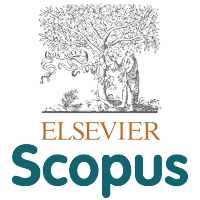Increased Production and Flavonoids of Two Celery Highland Varieties (Apium graveolens L.) by Endophytic Bacteria in Lowland
Abstract
Celery (Apium graveolens L.) is an annual plant that grows optimally in Indonesia’s highlands. The provision of endophytic bacteria has the role of plant protection, increasing agronomic growth and plant physiology, and overcoming environmental stresses. This study aims to assist the adaptation of highland celery varieties in the lowlands due to the decreasing agricultural highland and increase their production with endophytic bacteria applications. The experiment was executed in Bogor, Indonesia using a randomized block design with two factors. The celery variety served as the first factor [Amigo and Aroma (highland variety), and Summer Green (lowland variety)], and endophytic bacteria was the second factor (control, APE35, a combination of APE35+BAT, APE35+BAT+EQ26, and the PTM3 consortium). The result showed that endophytic bacteria helped the plants to adjust growth from highland to lowlands and increase yield. In lowland, Amigo showed shorter in height but it has a significantly higher stalk number, carotenoids, and flavonoids than Summer Green (lowland control). Endophytic bacteria increased plant growth, N, P, pigments, and flavonoids. APE35 or PTM3 with Amigo produced significantly higher leaf area, number of tillers, number of leaflets, leaf area, head fresh weight (78.529 and 75.054 g/plant), total fresh weight (81.67 and 85.395 g/plant), and total flavonoids (1484.818 and 1502.459 mg QE/100 g) than Summer Green without endophytic bacteria.
Keywords
Full Text:
PDFReferences
Afzal, I., Shinwari, Z.K., Sikandar, S., & Shaheen Shahzad, S. (2019). Plant beneficial endophytic bacteria: Mechanisms, diversity, host range, and genetic determinants. Microbiology Research, 221, 36-49. DOI
Angin, Y. P., Purwaningrung, Y., Asbur, Y., Rahayu, M.S., & Nurhayati. (2019). Utilization of secondary metabolite content produced by plants in biotic stress. Agriland, 7 (1), 39–47. website
Arisandi, R., & Sukohar, A. (2016). Celery (Apium graveolens L.) as a chemopreventive agent for cancer. Majority, 5 (2), 95–100. website
Asri, A.C, & Zulaika, E. (2016). Synergism between the consortium of Azotobacter isolates. ITS Journal of Science and Arts, 5 (2), 57–59. website
Bano, N., Rizvi, I. F., Sharma, N., Siddiqui, M.H., Khan, M. K. A., & Akhtar, S. (2016). Production of bioactive secondary metabolites from endophytic fungi. International Research Journal of Engineering and Technology (IRJET), 03 (06), 1859- 1866.
Clemente, A.A., Maciel, G. M., Siquieroli, A. C. S., Gallis, R. B. A., Pereira, L. M., & Duarte, J. G. 2021. High-throughput phenotyping to detect anthocyanins, chlorophylls, and carotenoids in red lettuce germplasm. International Journal of Applied Earth Observation and Geoinformation, 103. DOI
Du, H., Liu, H., & Xiong, L. (2013). Endogenous auxin and jasmonic acid levels are differentially modulated by abiotic stresses in rice. Frontiers in Plant Science, 4, 1–10. DOI
Ek-Ramos, M. J., Gomez-Flores, R., Orozco-Flores, A. A., Rodriguez-Padilla, C., Gonzalez-Ochoa, G., & Tamez-Guerra, P. (2019). Bioactive products from plant-endophytic gram-positive bacteria. Front. Microbiol. 10, 463. DOI
FAO ORG, 2022. Chapter one: Introduction – Fertilizer use by crop in Indonesia. website
Fazal, S. S & Singla, R. K. 2012. Review on the pharmacognostical & pharmacological characterization of Apium graveolens Linn. Indo Global Journal of Pharmaceutical Sciences, 2012; 2(1): 36-42. PDF
Gaiero, J. R., McCall, C. A., Thompson, K. A., Day, N. J., Best, A. S., & Dunfield, K. E. (2013). Inside the root microbiome: Bacterial root endophytes and plant growth promotion. American Journal of Botany, 100(9), 1738–1750. DOI
Gusmaini, Aziz, S. A., Munif, A., Sopandie, D., & Bermawie, N. (2013). The potency of Endophytic bacteria to increase the growth, biomass, and andrographolide yields of the Bitter King. Journal of Littri, 19 (4), 167–177.
Gusmaini, Kartikawati, A., & Nurhayati, H. (2019). The evaluation of endophytic bacteria application on nutrient efficiency of black pepper growth in Lampung. Jurnal Littri, 25 (2), 100–107. DOI
Handayani, L., & Widowati, L. (2020). Further analysis of empirical utilization of celery (Apium graveolens L.) by traditional healers. Indonesian Journal of Pharmacy, 10 (1), 31–41. DOI
Haridjaja, O., Putro, D., Baskoro, T., & Setianingsih, M. (2013). Differences in the value of water content in field capacity based on the Alhricks method, free drainage, and pressure plate on various soil textures and their relationship to the growth of sunflower (Helianthus annuus L.). Jurnal Ilmu Tanah dan Lingkungan, 15 (2), 52–59.
Hendrika, G., Rahayu, A., & Mulyaningsih, Y. (2017). Growth of celery (Apium graveolens L.) on various organic and synthetic fertilizers compositions. Journal of Agronida, 3 (1), 1–9.
Herlina, L., Kedati Pukan, K., & Mustikaningtyas, D. (2016). Study of endophytic bacteria producing IAA (Indole Acetic Acid) for plant growth. Sainteknol, 14 (1), 51–58.
Herlina, L., Pukan, K.K., Mustikaningtyas, D. (2017). The endophytic bacteria producing IAA (Indole Acetic Acid) in Arachis hypogaea. Cell Biology and Development, 1: 31-35. DOI
Jannah, H. (2016). Effect of paranet on temperature and humidity on the growth of Celery (Apium graveolens L.). JUPE, 1, 56–60.
Kartikawati, A., & Gusmaini, N. (2018). The potency of endophytic bacteria isolated from red ginger enhances black pepper seedlings' growth. Spice and Medicinal Plant Research Bulletin, 29 (1), 37–46. DOI
Kumar, S. & Pandey, A. K. (2013). Chemistry and biological activities of flavonoids: An overview. The Scientific World Journal, 2013, 16 p. DOI
Kumar, V., Ahluwalia, V., Saran, S., Kumar, J., Patel, A. K. Singhania, R. R. (2021). Recent developments on solid-state fermentation for production of microbial secondary metabolites: Challenges and solutions. Bioresource Technology 323:124566. DOI
Lakitan, B., Kartika, Susilawati, Wijaya, A. 2021. Acclimating leaf Celery plant (Apium graveolens) via bottom fresh culture to increase its adaptability to the tropical riparian freshland ecosystem. Biodiversitas 22: 320-328. DOI
Malik, A., Mor, V.S., Tokas, J., Punia, H., Malik, S., Malik, K., Sangwan, S., Tomar, S., Singh, P., Singh, N., Himangini, Vikram, Nidhi, Singh, G., Vikram, Kumar, V., Sandhya, Karwasra, A. (2021). Biostimulant-treated seedlings under sustainable agriculture: A global perspective facing climate change. Agronomy. 11 (1):14. DOI
Nasib, S. bin, Suketi, K., Winarso, D., & Widodo, D. (2016). Effect of plant growth-promoting rhizobacteria on papaya seedlings and early growth. Buletin Agrohorti, 4 (1), 63–69.
Nurchayanti, R., Asri, M.T., & Dewi, S.K. (2019). Potensi isolat bakteri endofit (B3), rhizobium, azotobacter dan azospirillum dalam memproduksi hormon Indole Acetic Acid (IAA). Bio Lantern, 8 (3), 1-6. website
Okungbowa, F. I., Shittu, H. O., & Obiazikwor, H. O. (2019). Endophytic Bacteria: hidden protective associates of plants against biotic and abiotic stresses. Notulae Scientia Biologicae, 11 (2), 167-174. DOI
Panche, A. N., Diwan, A. D., & Chandra, S.R. (2016). Flavonoids: An overview. Journal of Nutritional Science. 5, 1-15. website
Pothitirat W, Chomnawang MT, Supabphol R, & Gritsanapan W. (2009). Comparison of bioactive compounds content, free radical scavenging and anti-acne inducing bacteria activities of extracts from the mangosteen fruit rind at two stages of maturity. Fitoterapia. 80(7):442–447. DOI
Rudin, NA. (2020). Effect of abiotic stress on gene expression and concentration of secondary metabolites in Catharanthus roseus. Journal of Pro-Life, 7 (3), 262–274.
Sarker, A., Talukder, NM, & Islam, Md. T. (2014). Phosphate solubilizing bacteria promote growth and enhance nutrient uptake by wheat. Plant Science Today, 1 (2), 86–93. DOI
Sims, D.A. and Gamon, J.A. (2002) Relationships between leaf pigment content and spectral reflectance across a wide range of species, leaf structures and developmental stages. Remote Sensing of Environment, 81, 337-354. DOI
Trivedi, G., Shah, R., Patel, P. & Saraf, M. (2017). Role of endophytes in agricultural crops under drought stress: Current and future prospects. JAM, 3(4):174 – 188. website
Ulfa, A., Suarsini, E., Henie, M., & al Muhdhar, I. (2016). Isolation and sensitivity test of mercury in bacteria from gold mining waste in Sekotong Barat, West Lombok Regency: a preliminary study. Proceedings of Biology Education Conference, 13 (1), 793–799.
Waldemar Zielewicz, W., Wróbel, B., & Gniewko Niedbała, G. (2020). Quantification of chlorophyll and carotene pigments content in Mountain Melick (Melica nutans L.) in relation to edaphic variables. Forests, 11, 1197. DOI
Walpajri, F., Roza, RM, & Fitmawati. (2014). Exploration and test of the inhibition of endophytic bacteria from the brown parasite (Helixanthera sp.), brown parasite (Scurulla sp.), and coffee parasite (Helixanthera sp.) against Escherichia coli. JOM FMIPA, 1 (2), 1–10.
Yulianti, T. (2012). Exploring the potential of endophytes to improve sugarcane plant health supports sugar enhancement. Perspective, 11 (2), 113–123
DOI: http://doi.org/10.17503/agrivita.v45i2.3677
Copyright (c) 2023 The Author(s)

This work is licensed under a Creative Commons Attribution-NonCommercial 4.0 International License.








